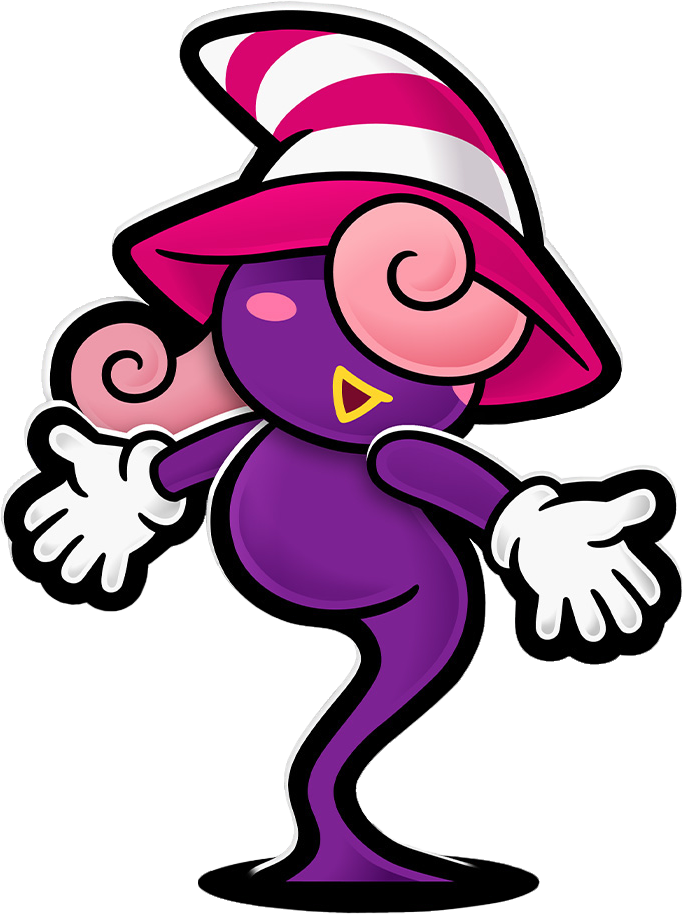Published 9 July 2024
Introduction

Developed by Intelligent Systems and published by Nintendo, Paper Mario: The Thousand-Year Door came out in 2004 in Japanese, English, German, French, Italian, and Spanish on the Nintendo GameCube. The original Japanese title is ペーパーマリオRPG (Paper Mario RPG). It is the second installment of the Paper Mario series and the fourth RPG in the Mario IP overall, after Super Mario RPG, Paper Mario, and Mario & Luigi: Superstar Saga, unless we count the RPG elements of the mobile Mario golf and tennis games. A complete remake of The Thousand-Year Door came out internationally in 2024 for the Nintendo Switch under the same title, changing the graphics, music, and, importantly here, the script.
Developers at Intelligent Systems have often taken a more daring and unusual approach to the Nintendo properties they work with. The Thousand-Year Door marks a departure from the studio’s earlier Paper Mario in how far it travels from the usual Mario setting and tone. While still appropriate for children and highly comedic, The Thousand-Year Door offers a more elaborate, sometimes dramatic storyline with darker themes and subject matter than the vast majority of Mario games, a trend that would be still further amplified in its less lauded sequel, Super Paper Mario.
Among the various subjects the script touches on is the gender variance or queerness of Vivian, one of the main characters. While I will not pretend this topic exists in a vacuum, there has been some controversy over the question of whether the 2004 Japanese script depicts Vivian as a transgender woman or an otokonoko/femboy, a point I will return to below. We will look at how exactly the different releases of The Thousand-Year Door portrayed this topic in 2004 and how this depiction was later revised.
To give credit to the specific real people who worked hard to produce the writing I will be discussing, the credits list Ryota Kawade as the chief director and Kaoru Kita, Tomoaki Fukuda, and Toshiyuki Nagahara as assistant directors. Hironobu Suzuki is listed as script director, but “script” is credited to Misao Fukuda. While “script” could refer to programming in this context, that there are distinct credits for “programming” suggests Hironobu Suzuki and Misao Fukuda were indeed responsible for writing the dialogue. As major a factor for the 2004 English release are the more numerous translators and localizers: Rich Amtower, Nate Bihldorff, Thomas Connery, Scott Richey, Bill Trinen, and Erik Peterson; “localization support” staff Mika Kurosawa and Norihide Sasaki; and “localization management” staff Jeff Miller and Leslie Swan.
The 2024 Switch remake credits Ryota Kawade as supervisor, while the director role passed to Masahiko Nagaya. Oddly enough, although the text of the script is largely identical, the remake’s credits do not clearly list any writers. “Game scripting” is attributed to Ryunosuke Kogi, Tasuku Kondo, Kaori Kawamura, Atsuki Kubota, and Raiki Hirose, but here this seems to mean programming rather than dialogue writing. The Switch remake’s localization credits are so extensive that it would be impractical to list them here. I cannot know what specifically these individuals did, such as whether a creative decision should be attributed to Suzuki or Fukuda or even Kawade, or who among the huge staff made a particular localization decision. Furthermore, different roles can often overlap in game design. What effect did the event designers have on the script writers, for instance, and what does the remake’s credit for “movies” refer to? I prefer to credit work to the people who did it, but given these considerations, I will not specifically refer to any of these creators below.
The different names I provide from the Japanese-language version of the script come from the Super Mario Wiki’s articles on Vivian, Marilyn, Beldam, Goom Goom, and The Thousand-Year Door and its remake; the page on Vivian from the Japanese-language Mario Wiki (apologies for using a Fandom site); and themushroomkingdom.net page “The Thousand-Year Door: From Japanese to English.” The quotations from the script I provide not from these sources I checked by consulting miscellaneous footage uploaded to YouTube as well as my own recordings. None of these are anything like formal academic sources, but they are sufficient for my purposes here.
If you are the sort who is worried about spoilers, you should not read more of this.